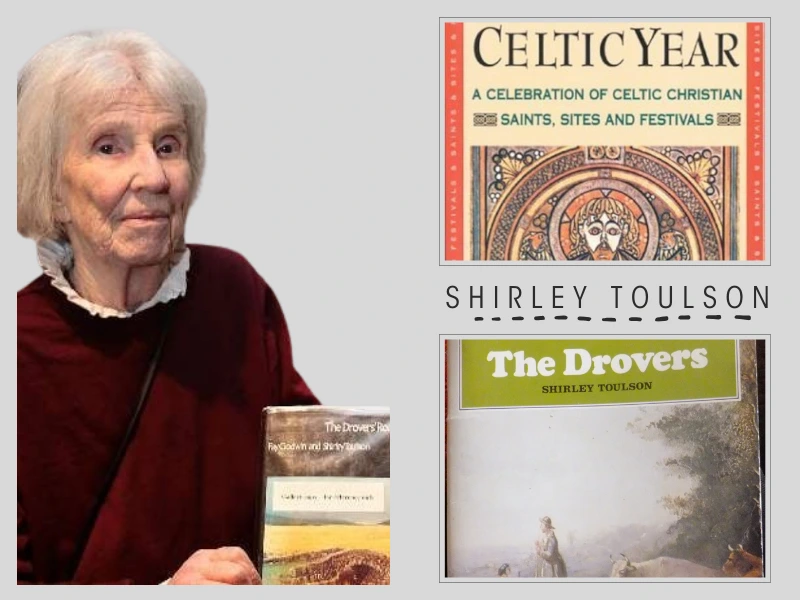Shirley Toulson Biography: The Voice of Time and Memories
Shirley Toulson was a well-known British poet, writer, and journalist, famous for her poetic work, which has the depth of time, memory, and human relationships. With her vivid imagery and deep emotional resonance, Toulson’s works have become timeless pieces in the world of literature. This blog goes into the life, career, and contributions of Shirley Toulson.
Early Life and Background
- Full Name: Shirley Toulson
- Date of Birth: May 20, 1924
- Place of Birth: Henley-on-Thames, Oxfordshire, England
- Nationality: British
Shirley Toulson was born into a family that valued literature and culture. Her upbringing in the serene countryside of Oxfordshire inspired much of her poetic imagery, which often reflects the natural beauty and transience of life.
Education and Literary Beginnings
Toulson pursued her education in literature and the arts. She studied at Somerville College, Oxford, where she developed her passion for poetry and creative writing. Her literary journey began early, with a natural flair for capturing emotions and vivid descriptions of her surroundings.
She started her career as a journalist and editor, which gave her exposure to various forms of writing. Her background in journalism sharpened her ability to express complex emotions concisely, a quality that permeates her poetry.
Books by Shirley Toulson
Shirley Toulson was a versatile writer known for her poetry, travelogues, and explorations of history and folklore. Below is a list of her most notable works:
1. Famous Poem: “A Photograph”
“A Photograph” by Shirley Toulson is a poignant poem that reflects on the passage of time, the inevitability of loss, and the power of memories. The poem captures a deep emotional bond between the poet and her mother through a photograph and underscores the transience of human life.
The Poem: “A Photograph”
The cardboard shows me how it was
When the two girl cousins went paddling,
Each one holding one of my mother’s hands,
And she the big girl—some twelve years or so.
All three stood still to smile through their hair
At the uncle with the camera. A sweet face,
My mother’s, that was before I was born.
And the sea, which appears to have changed less,
Washed their terribly transient feet.
Some twenty-thirty years later
She’d laugh at the snapshot. “See Betty
And Dolly,” she’d say, “and look how they
Dressed us for the beach.” The sea holiday
Was her past, mine is her laughter. Both wry
With the labored ease of loss.
Now she’s been dead nearly as many years
As that girl lived. And of this circumstance
There is nothing to say at all.
Its silence silences.”
Summary of the Poem
The poem is centered on a photograph that shows a treasured moment from the poet’s mother’s childhood. The photograph shows her mother and her two cousins holding hands, enjoying a holiday at the beach. The poet narrates the following stages of life:
- Childhood: The photograph shows the poet’s mother as a carefree girl, playing with the sea and her cousins.
- Adulthood: The poet recalls the day when her mother would laugh at the photograph, remembering her childhood with a mixture of nostalgia and wry humor.
- After Death: The poet juxtaposes these memories with the present, where her mother is no more. The silence of her absence is profound, and the poet feels the weight of this loss very deeply.
Key Themes
- Transience of Life: The poem highlights how life moves on, leaving only memories behind.
- Emotional Bond: The poet’s reflection on her mother’s photograph underscores the deep connection between them.
- Inevitability of Time: The poem captures the fleeting nature of life and how it affects relationships.

2. The Celtic Year: A Celebration of Celtic Christian Saints and Festivals
- Genre: History and Culture
- Summary: This book delves into the traditions, festivals, and Christian saints of the Celtic world, offering insights into their enduring cultural significance.
3. The Drovers (1976)
- Genre: Historical Non-Fiction
- Summary: Toulson explores the history of the drovers, who were responsible for transporting livestock across the countryside of Britain. The book sheds light on a lesser-known aspect of British rural life.
4. The Moors of the Southwest
- Genre: Travel and History
- Summary: This travelogue provides a vivid depiction of the moorlands of southwest England, blending history, folklore, and personal observations.
5. The Companion Guide to Devon and Cornwall
- Genre: Travel and Reference
- Summary: A detailed travel guide that explores the rich history, landscapes, and culture of Devon and Cornwall, making it a valuable resource for travelers.
6. The Celtic Alternatives
- Genre: History and Folklore
- Summary: This book examines the myths, traditions, and spiritual practices of Celtic culture, highlighting its influence on contemporary beliefs.
7. The Woven Cord: A Celebration of the Saints
- Genre: Spirituality and History
- Summary: Toulson celebrates the lives and legacies of saints across various traditions, weaving together their stories with historical context.
8. Walking the Hills and Moorlands of Britain
- Genre: Travel and Nature
- Summary: A comprehensive guide to exploring Britain’s hills and moorlands, filled with practical tips, history, and scenic routes.
9. In the Footsteps of Mary, Queen of Scots
- Genre: Historical Travel
- Summary: This book traces the journey of Mary, Queen of Scots, across Britain, offering a mix of history, travel, and intrigue.
10. The Last Heroes: The Final Campaign of the British Drovers
- Genre: History
- Summary: A sequel to The Drovers, this book chronicles the decline of the drovers’ profession and its impact on British rural life.
Themes in Her Writing
Shirley Toulson’s works are deeply reflective and often explore:
- Time and Transience: Her poem, A Photograph, revolves around the impermanence of life and the passing of time.
- Memory and Nostalgia: Her poems often bring in a sense of longing for something that has been lost in the past and capture fleeting moments of joy and sorrow.
- Family and Relationships: Toulson’s works emphasize the relationship between generations and, in particular, the parent-child relationship.
- Nature and the Countryside: Her love for the British countryside shines through in her descriptive travelogues and essays.
Also read William Blake Biography
Shirley Toulson’s Writing Style
Toulson’s writing style is marked by:
- Simplicity: She uses straightforward language to convey deep emotions.
- Imagery: Her vivid descriptions bring scenes and memories to life.
- Reflective Tone: Most of her works carry a meditative and contemplative quality.
- Universality: Despite being personal, her themes resonate universally with readers.
Recognition and Legacy
While Shirley Toulson may not have gained widespread fame during her lifetime, her poetry and prose have left an enduring impact on readers worldwide. Her works, particularly A Photograph, are studied extensively in academic circles for their depth and emotional resonance.
Toulson’s ability to capture universal themes of time, memory, and loss makes her a timeless figure in literature.
Awards and Recognition of Shirley Toulson
While Shirley Toulson is primarily celebrated for her literary contributions, particularly her evocative poetry and insightful travelogues, she did not receive major international literary awards during her lifetime. Her enduring legacy, however, is the inclusion of her works in academic curricula and her influence on readers and scholars.
Achievements of Shirley Toulson
Shirley Toulson is remembered as a talented poet, writer, and historian whose works have left a lasting impact on literature and education. Although she may not have received widespread awards or accolades, her achievements are reflected in her literary contributions and influence.
Personal Life
Shirley Toulson was a private individual who drew much inspiration from her surroundings and personal experiences. Her deep connection to her roots and her reflective nature are evident in her writing. She preferred the tranquility of the countryside, which fueled her creativity and introspection.
Interesting Facts About Shirley Toulson
- Focus on Relationships: Much of her poetry explores relationships, particularly between parents and children.
- Inspired by Nature: Growing up in the picturesque Oxfordshire countryside had a profound impact on her imagery and themes.
- Influence on Education: Her poem A Photograph is part of the curriculum in many schools, where it teaches students about life, loss, and memory.
Conclusion
Shirley Toulson’s literary contributions, though not so vocal, contribute significantly to the literature world in terms of poetry and prose. Her style of being able to express the subtle elements of human emotions and time passing fills all readers with an energy that cannot be gone through across generations. Toulson reminds one of the beauty and fragility of life in such tragic details: cherish every moment.
FAQs
Who is Shirley Toulson in a short note?
Shirly Toulson is a British poet, writer, and historian, famous for reflective poetry and interesting travelogues. One of her most well-known poems, A Photograph, discusses themes about memory, loss, and passing time. In many of her works, Shirly Toulson brings to life the blending of personal experience with universal feelings, which puts her among modern great literature figures.
What is the legacy of Shirley Toulson?
Shirley Toulson’s legacy lies in her ability to capture the fragility of life and the power of memories in her poetry. Her poem A Photograph remains widely studied and celebrated for its emotional depth and universal themes. Additionally, her historical and travel writings contributed significantly to the understanding of British cultural heritage.
Why is the title A Photograph by Shirley Toulson?
The title A Photograph symbolizes the frozen moments of time captured in a photograph, serving as a poignant reminder of the transient nature of life. It reflects how photographs preserve memories, even as the people in them and the moments they depict fade away.
Who wrote the poem A Photograph?
The poem A Photograph was written by Shirley Toulson. It is one of her most famous works, widely acclaimed for its exploration of time, memory, and the enduring impact of loss.



